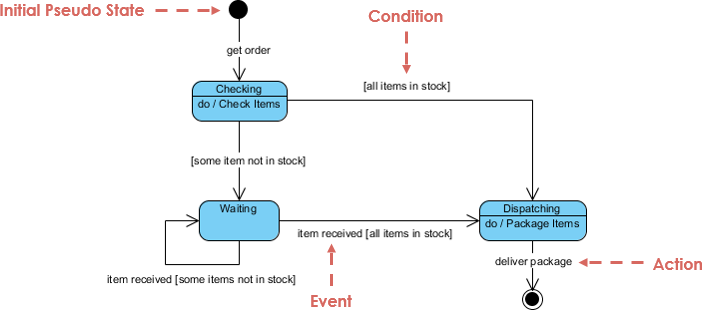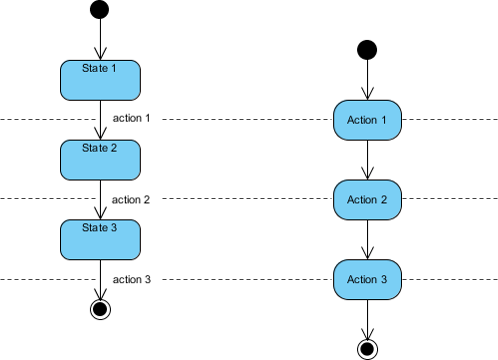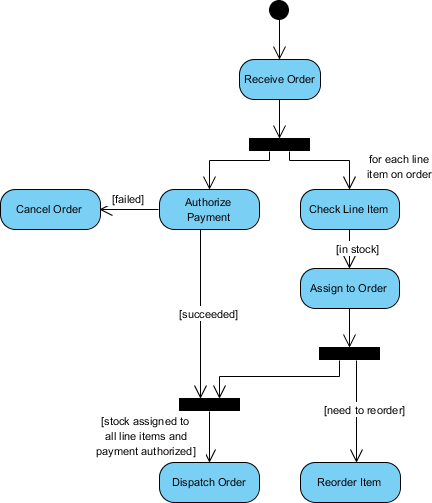Diagram stanowy jest abstrakcyjną reprezentacją procesu. Jest powszechnie używany w informatyce do modelowania procesów języków programowania i może również pomóc analitykom w mapowaniu procesów biznesowych. Elementy systemu nazywane są zazwyczaj obiektami i mogą zmieniać stan.
Te transformacje w Zjednoczonym Języku Modelowania (UML) są śledzone w całym diagramie (znanym również jako diagram maszyny stanowej UML). Diagramy stanowe UML mogą uchwycić cykl życia obiektów, podsystemów i systemów oraz mogą informować o stanie, jaki obiekt może mieć, oraz o tym, jak zdarzenia (takie jak odbiór wiadomości, upływ czasu, błędy, warunki są prawdziwe itp.) będą ewoluować w czasie, aby wpływać na te stany.
Diagram stanowy może być również używany do opisywania różnych stanów obiektu, procesu przejścia między stanami oraz różnych zdarzeń i warunków, które wyzwalają przejścia stanów.

Czym jest przejście stanu?
Przepływ diagramu stanowego jest zazwyczaj określany przez występujące przejścia. Niektóre stany obiektów mogą być przekształcane w stany zbędne. Czasami wiele przejść może prowadzić do tego samego stanu, co może powodować zamieszanie. W takim przypadku więcej niż jeden prostokąt może być enkapsulowany w innym prostokącie, który zazwyczaj nazywany jest superstanem. Jeśli zdarzenia i przejścia w systemie są złożone, ten format może ułatwić odczytanie diagramu stanowego.
Diagram stanowy vs Diagramy przepływu
Ludzie często mylą diagramy stanowe z diagramami przepływu. Rysunek poniżej pokazuje porównanie diagramu stanowego z diagramem przepływu. Diagram maszyny stanowej na rysunku po lewej stronie poniżej wykonuje działania w odpowiedzi na wyraźne zdarzenia. W przeciwieństwie do tego, diagram aktywności na rysunku po prawej stronie poniżej nie potrzebuje wyraźnych zdarzeń, lecz przejścia z węzła do węzła w swoim grafie automatycznie po zakończeniu działań.

Czym jest diagram aktywności?
Diagramy aktywnościopisują działania, które obejmują współbieżność i synchronizację, które są wariantem diagramów stanowych koncentrującym się na przepływie działań i zdarzeń. Mogą być używane do:
- Do modelowania zadania ludzkiego (na przykład procesu biznesowego).
- Do opisania funkcji systemu, która jest reprezentowana przez przypadek użycia.
- W specyfikacjach operacji, aby opisać logikę operacji.

Diagram aktywności vs Diagram maszyny stanowej
Diagram aktywności
W semantyce UML, diagramy aktywności można zredukować do maszyn stanowych z dodatkowymi notacjami, że wierzchołki reprezentują realizację aktywności, a krawędzie reprezentują przejście od zakończenia jednej grupy aktywności do rozpoczęcia nowej grupy aktywności. Diagramy aktywności uchwycają aspekty działań na wysokim poziomie. W szczególności możliwe jest przedstawienie współbieżności i koordynacji w diagramach aktywności.
Zobacz diagram aktywności, który modeluje przepływ działań dla incydentu. Taki diagram aktywności koncentruje się na przepływie danych w systemie.

Diagram maszyny stanowej
W maszynach stanowych wierzchołki reprezentują stany obiektu w klasie, a krawędzie reprezentują wystąpienia zdarzeń. Dodatkowe notacje uchwycają, jak są koordynowane działania. Obiekty mają zachowania i stany. Stan obiektu zależy od jego bieżącej aktywności lub warunku. Diagram maszyny stanowej pokazuje możliwe stany obiektu oraz przejścia, które powodują zmianę stanu.
Zobacz diagram maszyny stanowej poniżej. Modeluje on przejścia stanów dla incydentu. Taki diagram stanowy koncentruje się na zestawie atrybutów pojedynczej abstrakcji (obiektu, systemu).

Spróbuj teraz narysować diagram maszyny stanowej UML
Nauczyłeś się, czym jest diagram maszyny stanowej i jak go narysować. Czas narysować własny diagram maszyny stanowej. Pobierz Visual Paradigm Community Edition, darmowe narzędzie UML, i stwórz własny diagram maszyny stanowej za pomocą darmowego narzędzia do diagramów maszyny stanowej. Jest łatwe w użyciu i intuicyjne.
Powiązane linki
Ten post dostępny jest również w Deutsch, English, Español, فارسی, Français, Bahasa Indonesia, 日本語, Portuguese, Ру́сский, Việt Nam, 简体中文 and 繁體中文













